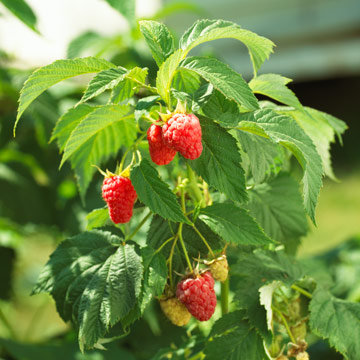






Raspberries and cream, raspberry jam, raspberry liqueur: The possibilities seem endless when you know how to grow your own raspberries. These delicate berries are treats straight off the plant, as well as a winter surprise when frozen in a single layer on a cookie sheet and then bagged up to provide a taste of summer on some cold, dark day.
Learn how to grow raspberries in containers.
continue reading belowFirst, decide how to grow raspberries by choosing the right type for you. Raspberries come in two categories: summer bearing and fall bearing (also called everbearing).
Summer-bearing plants produce one big crop of fruits in late summer. Fall-bearing plants produce two crops a year: one in early autumn and a smaller crop early the next summer. Raspberries come in three common colors: red (varieties such as 'Latham', 'Autumn Bliss', and 'Heritage'), black (varieties such as 'Blackhawk' and 'Bristol'), and yellow (varieties such as 'Honeyqueen' and 'Fallgold'). In general, red raspberries are stronger, hardier, and more productive than the black and yellow raspberry plants.
Raspberries are vigorous growers and will produce runners that fill up a bed. Choose a spot in full sun and well-drained soil; dig in some compost to give them a jump-start. You can buy raspberries bare-root in the spring or as container-grown plants for spring, summer, or autumn planting. Regardless, plant the canes 20 inches apart and rows 5 feet apart. The canes will fill in all the available spaces, and all you need to do is dig up those that venture out into the path.
How to prune raspberries largely depends on the type of raspberries you're growing. Summer-bearing plants are easy -- when an individual cane bears fruit, you can cut it back to the ground after you've harvested all the fruit from it; individual canes bear fruit only once. Be sure to leave all the new canes that have yet to bear fruit -- those will bear fruit next year.
Because fall-bearing raspberries will give you a second crop the following summer, you'll want to wait to prune them back until the next autumn. Or here's a trick used by many raspberry growers: Instead of getting two crops, cut down the entire stand in early spring. The resulting growth will produce one big late crop -- you'll have an abundance of raspberries when everyone else's canes are bare.
Raspberries grow 4-6 feet high; it isn't necessary to trellis them as long as you have room for the canes to arch slightly as the fruit ripens. A small bed is fine for a freestanding raspberry patch. If you want to grow a row or two or you prefer a tidier look in the garden, install a wire fence with two or three vertical wires attached to T-bar posts at the ends of the rows so the canes grow up supported by wires on either side.
Harvest raspberries by gently tugging at the berries. They don't keep well, so eat fresh or freeze.
You may see a misshapen raspberry -- a berry that is drawn up on one side or another. That's the result of poor pollination, which could be caused by a cold, wet spring. You might consider keeping mason bees, which emerge earlier than honeybees and do a great job at pollinating all sorts of plants, even in cool weather.
Powdery mildew is a common disease for raspberries; be sure to clean up all fallen fruits and leaves to keep the mildew at a minimum. This will also help control raspberry rust -- a disease that produces rusty dots on the leaves.
Raspberries are one of the easiest, most rewarding, and most productive fruits to grow in the home garden. Once you know how to grow raspberries, you'll be providing the neighborhood with summer fruit.
Copyright © www.100flowers.win Botanic Garden All Rights Reserved